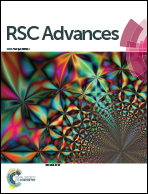Effect of defects and film thickness on the optical properties of ZnO–Au hybrid films
Abstract
Electronic structure and optical properties of ZnO(y nm)–Au(10 nm) hybrid films, with y = 20, 50 and 150, have been investigated for effective coupling of surface plasmon resonance (SPR) of Au nanoparticles (NPs) with ZnO band structure to enhance their optical properties. The films have been synthesized by a pulsed laser deposition method and studied by UV-Visible absorption, Raman, Photoluminescence, and X-ray absorption near-edge structural analyses. The effect of defects on coupling of SPR with ZnO band structure has been discussed based on optical and electronic structural studies. The local electronic structure analysis at the O K-edge reveals that, in the thinnest film more unoccupied states are introduced in ZnO due to hybridization of O 2p–Au 5d/6s orbitals. The increased density of states causes the enhanced optical properties of ZnO–Au hybrid films via increasing the population at the conduction band of ZnO. Our experimental findings demonstrate that in the thickest film, the exponential decay of SPR induced local field and defects are the main factors affecting the coupling of SPR with the ZnO band structure.


 Please wait while we load your content...
Please wait while we load your content...